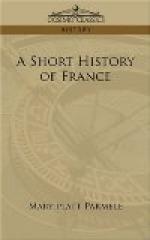As the hour of doom approached, labor ceased, the fields were untouched, and when to pestilence and despair was added famine, then men’s hearts failed them even under coats of mail. The Church came to the rescue with the “Truce of God,” which, in the hope of appeasing an avenging God, forbade private wars during certain periods in the ecclesiastical year. Repentant barons, with a similar hope, made peace with their neighbors, and their swords rusted as they built monasteries and chapels; or some not yet obtaining peace, and perhaps restless with their occupation gone, made pilgrimages to Rome, to pray at the graves of Peter and Paul, and still others even to Jerusalem, that the breath from Calvary might whiten their sin-steeped souls.
It is interesting to note that among these penitent pilgrims, sixty years before the first Crusade, was that Duke of Normandy known as “Robert the Devil,” whose pagan ancestor only a century before had been the terror of European civilization, and whose son, thirty years later, was to wear the crown of England.
In this way were the currents setting steadily toward the Holy Sepulchre as the panacea for human woes which were sent by an avenging God. These were the first stirrings of the breath of the coming storm which in eight successive waves was soon to sweep over Europe. The way was preparing for the great event of the Middle Ages.
Whatever its motives, the abstaining from slaughter, and the building of cathedrals and monasteries and abbeys, was weaving a mantle of beauty for France, which she still proudly wears. And the greatest of the builders was the Duke of Normandy; and it is to his dukedom the art student turns for the most perfect blending of grace and grandeur, characteristic of the early style. The marvel to which this is intended to draw attention is the preeminent position swiftly attained in France by this brilliant race, in every department of living. It would seem that France did not adopt this terrible child from the north, but that he adopted France, and changed and gave color to her whole future. It was a tempestuous element, but it was new life, and it is impossible to conceive of what that country would have been without this stimulating, brilliant infusion into its national life.
With such marvellous facility did this people adopt the speech and manners of their neighbors, that in the year 1066 they were prepared to instruct the Britons in the ways of a more polished civilization. Only a century before the birth of William the Conqueror, his ancestors had lived by looting. They were highwaymen and robbers by profession. His mother, a Norman peasant girl, daughter of a tanner, won the love of that gay duke known as “Robert the Devil.” William, the child of this unconsecrated union, upon the death of his father succeeded to the dukedom. One of the steps in the rapid climb of this family of Rollo had been a marriage connecting them with the royal family of England. King Edward, William’s remote cousin, died without an heir. Here was an opportunity. With sixty thousand Norman adventurers like himself, William started with the desperate purpose of invading England and wresting the crown from his cousin Harold.




